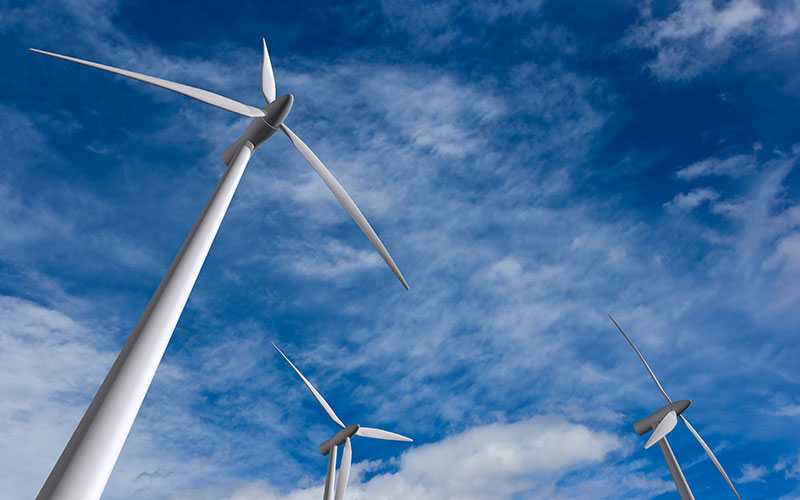
Opponents of clean energy say it isn't a reliable source of power. This study proves otherwise. Photo: Shutterstock.
I love New England winters. There’s nothing like downhill skiing around northern New England. But this winter’s extreme cold snaps have me starting to look forward to spring. Add to that the drastic spike in electricity costs – my electricity bills this season have doubled on average, and the rest of New England is feeling the same pressure.
So how do we keep the lights and heat on, our climate safe, and our energy bills low even in the coldest temperatures? Major players, like our regional grid operator (ISO New England) and Big Gas, insist that we must remain tied down to climate-damaging fossil fuels as the solution. Their position is in stark contrast to regional climate laws and policies that mandate cuts to polluting emissions. Clearly, we need to drastically increase our clean energy generation to meet these mandates. But can clean energy really provide a reliable source of energy supply – even in our times of greatest need, like the cold snaps we’ve experienced this winter?
A recent study by RENEW Northeast, a nonprofit that convenes energy and environmental groups interested in furthering renewable energy (including CLF), says yes. Specifically, it affirms that more offshore wind can keep our heat and lights on even during New England’s deepest freeze, lower our energy bills, and slash climate-damaging emissions. Here’s why.
Natural Gas is Price Volatile, Offshore Wind Isn’t
We’ve experienced firsthand how unstable and unpredictable natural gas prices are. That’s, in part, because New England depends on importing liquified natural gas. Importing our fuel supply means we must contend with drastically inflated prices when international crises affect supply chains – crises like Russia’s ongoing war on Ukraine. Additionally, our electric grid operator resorts to the dirtiest and most expensive fuels like oil and coal when it needs back-up fuel supplies during cold snaps that push energy demand higher.
In contrast, energy generated by offshore wind is much more stable. Because of long-term contracts, offshore wind suppliers can lock in a steady price for decades at a time – which means no volatile price spikes because of external influences or cold snaps. These consistent prices also provide offshore wind a competitive edge against fossil fuels like natural gas, which helps us transition more quickly off such climate-damaging fuels.
We saw the consequence of our over-reliance on natural gas just a few months ago. Prices spiked on Christmas Eve – when gas generators failed to provide enough supply and our grid operator turned to pricey, polluting oil instead. The reality is, if more offshore wind had been available, we wouldn’t have paid such high electricity bills.
Offshore Wind Increases Electricity Production in Cold Temperatures
New England is windier when it’s cold. Wind blows much more strongly and consistently in the ocean during the winter. And heavy winds tend to accompany cold snaps.
These three facts mean offshore wind can actually produce more electricity during this frigid season. The extra energy produced can fill the gap in energy supply during peak demand – such as when everyone is using their heat and appliances. This extra energy also means we don’t have to resort to our dirtiest fuels when seeking back up energy reserves, as we’ll have less other, less polluting energy resources on the grid to exhaust first.
Fighting Climate Change Slows the Frequency of Cold Snaps
Climate change and extreme weather fluctuations are directly linked. As climate change worsens, we’re only going to see more frequent and severe cold snaps, which means more persistently threatened energy supply and expensive periods of price spikes.
The irony is, the very fuels ISO-New England touts as the solution to energy reliability problems cause climate change. Fossil fuels spew polluting emissions that damage our climate and create consequences like the extreme temperature fluctuations we’ve experienced this winter.
That’s yet another reason why offshore wind will increase our region’s energy reliability. It uses a form of renewable energy that not only can’t be depleted but that also doesn’t create the dangerous emissions fueling climate change. Clean energy sources like wind are critical to slashing polluting emissions to net-zero by 2050 – and slowing climate change and its consequent cold snaps from becoming more extreme and frequent.
Clean Energy Like Offshore Wind Is the Path Forward
Clean energy opponents like to claim that offshore wind and solar energy are unreliable and will threaten our energy system. But through this study, RENEW Northeast shows the opposite. It affirms that offshore wind is dependable and reliable, even in New England’s frigid winters. So, developing more of this clean energy source will alleviate the pressure of energy price spikes and climate change at the same time.
RENEW Northeast recommends New England develop more renewable energy, particularly offshore wind – and we agree. We must support responsible offshore wind in our region. And we must also hold our regional grid operator accountable for putting up obstacles that have prevented more renewable energy in the grid.
Climate change threatens our health, our wallets, and our safety. Offshore wind offers untapped potential to help keep the worst effects of the climate crisis at bay. Clean energy resources can help us escape fossil fuels’ volatile energy prices. And that means not having to forego heating our homes or keeping the lights on during the next cold snap.



